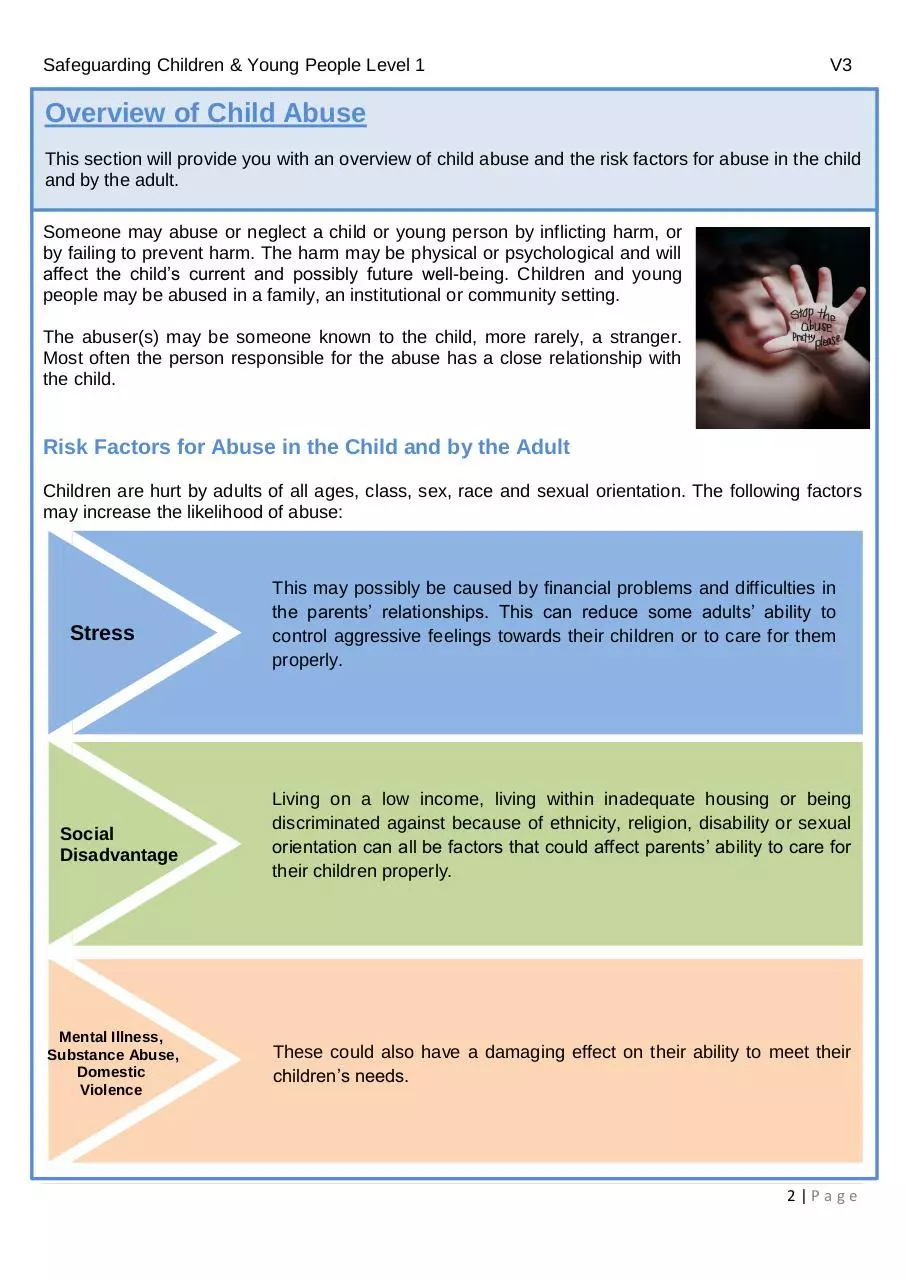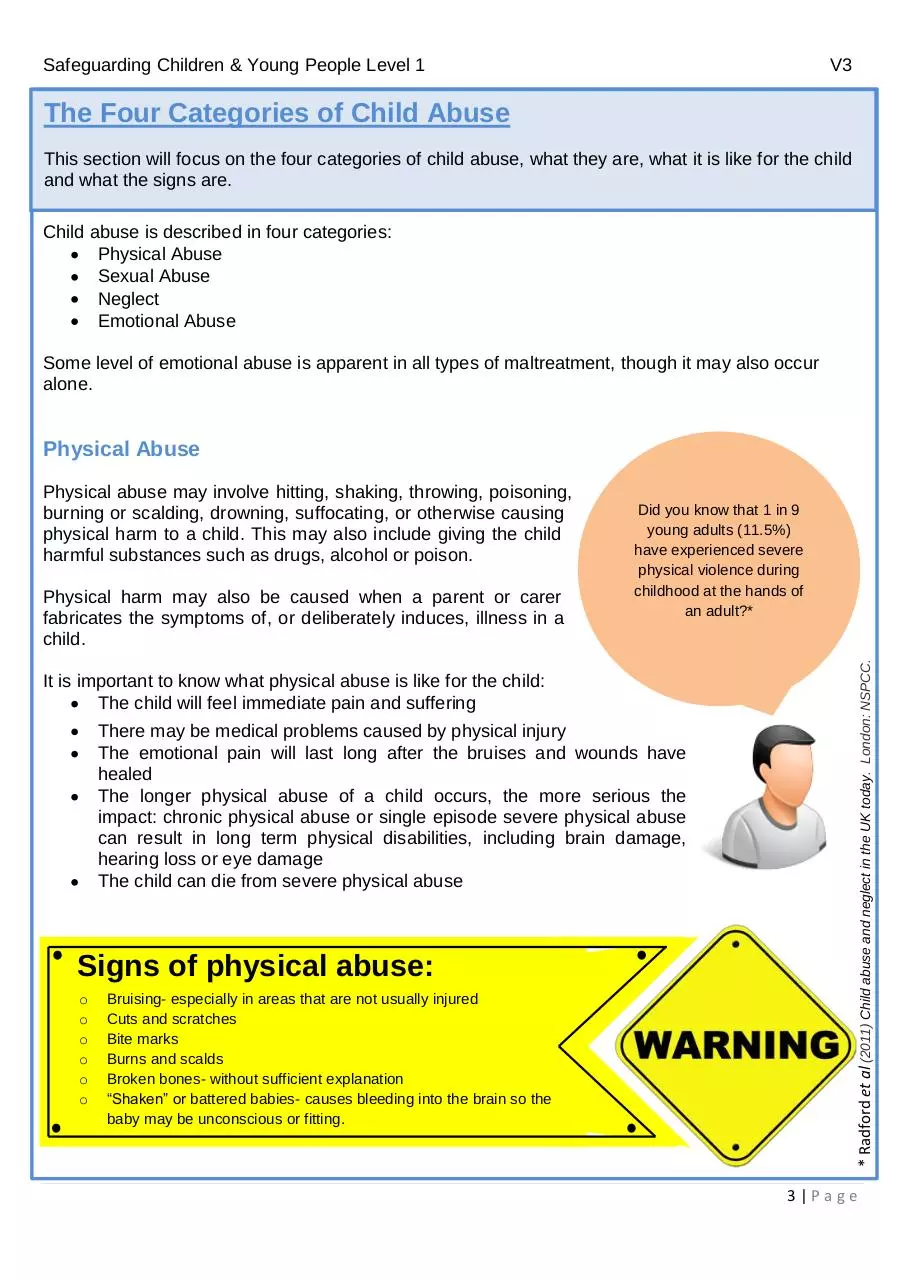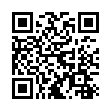Safeguarding Children Level 1 Workbook V3 APP VERSION (PDF)
File information
Author: gedci
This PDF 1.5 document has been generated by Microsoft® Word 2010, and has been sent on pdf-archive.com on 15/07/2014 at 14:35, from IP address 194.176.x.x.
The current document download page has been viewed 904 times.
File size: 1.11 MB (14 pages).
Privacy: public file





File preview
Safeguarding Children & Young People Level 1
V3
This workbook has been compiled jointly between the lead trainers and the Learning and
Development Team for non-clinical staff working in a healthcare setting.
Overview
This module explains what the term safeguarding children and young people involves for all staff
working in healthcare settings. You will learn about the different types of child abuse and neglect, as
well as how you might be able to recognise the signs within children and young people.
The course goes on to look at what you should do if you are concerned that a child is being abused
or neglected. It explains the steps you need to take in order to protect them from further harm. It is
important to note that the term “children” means children and young people from birth up to their 18 th
birthday.
By the end of this workbook you will be able to:
Identify child maltreatment
Discuss your role in safeguarding children and young
people
Define the main categories of abuse
Recognise common signs of child abuse
Recognise how frequently children are abused
Know what to do if you have concerns that a child is
being abused or neglected or is at risk
Know how to seek guidance and support
0|Page
Safeguarding Children & Young People Level 1
V3
Aims for Children Growing Up in the UK
This section will focus on the Department of Health’s Every Child Matters policy and the UK’s aim for
children growing up within the UK. It will also touch on the change in law and guidance around
protecting children and the role of staff within healthcare organisations.
Children need to be supported by their parents, carers and society. This support extends to school,
play and sporting settings as well as in the community and within all healthcare settings.
The aim for every child in the UK, whatever their background may be, is to have the support that they
need to:
Be healthy
Stay safe
Enjoy and achieve
Make a positive contribution
Achieve economic well-being
The above are the five aims of Every Child Matters: Change for Children. This is the policy
supporting the well-being of children and young people from birth to their 18 th birthday.
Following the deaths of Victoria Climbié and Baby Peter, the law and guidance around protecting
children was changed. The focus was broadened from protecting to safeguarding children.
Safeguarding involves promoting the welfare of children and preventing impairment of children’s
health or development. The aim is for all children to grow up in circumstances consistent with the
provision of safe and effective care. This will enable them to have optimum life chances so that they
enter adulthood successfully. Protecting children from maltreatment, supporting families at risk,
identifying and ensuring the safety of children who are or might be being abused is a vitally important
part of safeguarding.
Staff members working within health organisations have an
important role, in face a duty, as outlined in the law to ensure that
they safeguard and promote the welfare of children and young
people. This includes being able to recognise signs of possible
child abuse and neglect.
Baby Peter
In order to carry out their
duty to safeguard children,
all staff working in a
healthcare setting need to
be able to understand and
recognise signs of abuse
and neglect in children
1|Page
Safeguarding Children & Young People Level 1
V3
Overview of Child Abuse
This section will provide you with an overview of child abuse and the risk factors for abuse in the child
and by the adult.
Someone may abuse or neglect a child or young person by inflicting harm, or
by failing to prevent harm. The harm may be physical or psychological and will
affect the child’s current and possibly future well-being. Children and young
people may be abused in a family, an institutional or community setting.
The abuser(s) may be someone known to the child, more rarely, a stranger.
Most often the person responsible for the abuse has a close relationship with
the child.
Risk Factors for Abuse in the Child and by the Adult
Children are hurt by adults of all ages, class, sex, race and sexual orientation. The following factors
may increase the likelihood of abuse:
Stress
Social
Disadvantage
Mental Illness,
Substance Abuse,
Domestic
Violence
This may possibly be caused by financial problems and difficulties in
the parents’ relationships. This can reduce some adults’ ability to
control aggressive feelings towards their children or to care for them
properly.
Living on a low income, living within inadequate housing or being
discriminated against because of ethnicity, religion, disability or sexual
orientation can all be factors that could affect parents’ ability to care for
their children properly.
These could also have a damaging effect on their ability to meet their
children’s needs.
2|Page
Safeguarding Children & Young People Level 1
V3
The Four Categories of Child Abuse
This section will focus on the four categories of child abuse, what they are, what it is like for the child
and what the signs are.
Child abuse is described in four categories:
Physical Abuse
Sexual Abuse
Neglect
Emotional Abuse
Some level of emotional abuse is apparent in all types of maltreatment, though it may also occur
alone.
Physical Abuse
Physical harm may also be caused when a parent or carer
fabricates the symptoms of, or deliberately induces, illness in a
child.
Did you know that 1 in 9
young adults (11.5%)
have experienced severe
physical violence during
childhood at the hands of
an adult?*
It is important to know what physical abuse is like for the child:
The child will feel immediate pain and suffering
There may be medical problems caused by physical injury
The emotional pain will last long after the bruises and wounds have
healed
The longer physical abuse of a child occurs, the more serious the
impact: chronic physical abuse or single episode severe physical abuse
can result in long term physical disabilities, including brain damage,
hearing loss or eye damage
The child can die from severe physical abuse
Signs of physical abuse:
o
o
o
o
o
o
Bruising- especially in areas that are not usually injured
Cuts and scratches
Bite marks
Burns and scalds
Broken bones- without sufficient explanation
“Shaken” or battered babies- causes bleeding into the brain so the
baby may be unconscious or fitting.
* Radford et al (2011) Child abuse and neglect in the UK today. London: NSPCC.
Physical abuse may involve hitting, shaking, throwing, poisoning,
burning or scalding, drowning, suffocating, or otherwise causing
physical harm to a child. This may also include giving the child
harmful substances such as drugs, alcohol or poison.
3|Page
Safeguarding Children & Young People Level 1
V3
What always needs to be taken into account?
The child’s age and stage of development e.g. a baby who is
immobile should not have bruises anywhere unless there is clear
history of trauma such as a car accident, while a school aged
child will usually have a couple of bruises on their shins caused
during play.
Take the child’s, parent or carers explanation
for the injury, where possible. In abuse, the
parent’s explanation may not fit with the injury
visible or seem very vague and they may
change their story every time they are asked.
The child may have been “trained” to echo the
parent’s explanation.
Signs of physical abuse can
also be more subtle. For
example a child may be
fearful, shy away from touch,
be reluctant to change for
PE or games and also may
appear to be afraid to go
home
Examples of Physical Abuse in Children
Multiple large bruises to the leg of a young child
These bruises are many more than you would expect from normal
childhood play.
These bruises are actually as a result of kicking.
A broken bone
Dressing a little baby would not cause this sort of injury.
This is a fractured humerus (broken bone in upper arm) in a
six week old infant, whose mother said that the arm broke
whilst dressing the child.
Bruising to the rim of the ear
This kind of injury is caused when the ear has been
pinched repeatedly, with a lot of force.
Again, not a bruise that would happen by accident.
4|Page
Safeguarding Children & Young People Level 1
V3
Sexual Abuse
Sexual abuse involves forcing or enticing a child or young person
to take part in sexual activities, not necessarily involving a high
level of violence, whether or not the child is aware of what is
happening.
The activities may involve physical contact, including assault by
penetration (for example, rape or oral sex) or non-penetrative
acts such as masturbation, kissing, rubbing and touching outside
of clothing.
They may also include non-contact activities, such as involving
children in looking at, or in the production of, sexual images,
watching sexual activities, encouraging children to behave in
sexually inappropriate ways, or grooming a child in preparation for abuse (including via the internet).
Sexual abuse is not solely perpetrated by adult males. Women can also commit acts of sexual abuse,
as can other children.
It is important to know what sexual abuse is like for the child. The most common reaction that the
child feels is terrific shame. They may have tried to tell someone but not have been believed. They
may even have been blamed for what has happened. Many sexually abused children wait until they
are much older to tell anyone what happened to them, or may never even tell.
What are the characteristics of a child sex abuser?
Abusers may act alone or as part of an organised group. After the
abuse, they will put the child under great pressure not to tell
anyone about it. They will go to great lengths to get close to
children to win their trust, or pretending to be children on the
internet via chat rooms run for children and
young people. This is commonly known as
being “groomed”. This may be for purposes
of trafficking or sexual exploitation. Child sex
abusers are sometimes referred to as
“paedophiles” or “sex offenders”, especially if
they are not family members.
Child sex abusers can come
from any professional, racial
or religious background,
male or female. Usually the
abuser is a family member or
someone known to the child,
such as a family friend.
Signs of sexual abuse:
o
o
o
o
o
Anxious about going to a particular place or seeing a particular
person
Suddenly starts having behaviour problems such as being aggressive
Suddenly starts having extreme mood swings such as brooding,
crying or fearfulness
Has sudden deterioration in school results
Displays unexpectedly explicit knowledge for their age
5|Page
Safeguarding Children & Young People Level 1
V3
More Signs of sexual abuse:
o Exhibits regressive behaviour, e.g. starts wetting the bed
again, having previously been dry at night
o Engages in risky behaviours such as drug taking,
unprotected sex with numerous partners (in an
adolescent stage)
o Starts harming themselves
Most children presented with an allegation or histories of sexual abuse do not have
any signs of physical damage when examined by a doctor. This is because the abuse
may have occurred sometime before the examination and injuries to the genital area
heal very quickly or because the abuse was non-penetrative. For example, kissing.
Neglect
Neglect is the persistent lack of appropriate care of children. This
includes lack of love, stimulation, safety, nourishment, warmth,
education and medical attention.
It is important to know what neglect is like for the child. Neglect is the
persistent failure to meet a child’s basic physical and/or
psychological needs, likely to result in the serious impairment of the
child’s health or development.
Neglect may occur during pregnancy as a result of maternal
substance abuse. Once a child is born, neglect may involve a parent
or carer failing to:
Provide adequate food, clothing and shelter (including exclusion from home or abandonment)
Protect a child from physical and emotional harm or danger
Ensure adequate supervision (including the use of inadequate care-givers)
Ensure access to appropriate medical care or treatment.
It may also include neglect of, or unresponsiveness to, a child’s basic emotional needs.
Child neglect is not always deliberate. Sometimes, a caregiver becomes physically or mentally
unable to care for a child, such as in untreated depression or anxiety. Other times, alcohol or drug
abuse may seriously impair judgement and the ability to keep a child safe. The end result, however,
is a child who’s physical and/or emotional needs are not being met.
6|Page
Safeguarding Children & Young People Level 1
V3
Examples of Neglect
Hungry Child
An infant or child always feeling hungry. Not being fed properly
could lead to them not growing properly.
Dirty clothes and smelling bad
Due to their dirty clothes and smell they could be rejected at
school by other children.
Bad living conditions
Living in a filthy house with no clean bed to
sleep in and no proper bedtime can lead to
the child always feeling tired.
Not receiving medical care
Not getting medical care when needed because the parent is
too drunk or drugged to recognise the illness which results in
presenting very late into an illness, with a potential fatal
outcome
7|Page
Safeguarding Children & Young People Level 1
V3
Tooth decay
Neglected teeth resulting in excessive tooth decay. A child
who has possibly never been taken to a dentist despite visible
tooth decay.
Nappy rash
Nappy rash in a two year old neglected child. Nappy rash
is quite common but most parents will take prompt steps
to get advice and treat it.
Signs of neglect:
Physical Signs
o
o
o
o
Ill-fitting, dirty clothes and shoes
Not dressed warmly enough in cold weather
Appearing very dirty, with matted and unwashed hair
Untreated or delayed treatment of illness
Signs of neglect:
Behavioural Signs
o
o
o
o
Unsupervised young children playing outside
Left alone at home
Frequently late for school
Troublesome, disruptive behaviour or withdrawn and
passive
8|Page
Download Safeguarding Children Level 1 Workbook V3 - APP VERSION
Safeguarding Children Level 1 Workbook V3 - APP VERSION.pdf (PDF, 1.11 MB)
Download PDF
Share this file on social networks
Link to this page
Permanent link
Use the permanent link to the download page to share your document on Facebook, Twitter, LinkedIn, or directly with a contact by e-Mail, Messenger, Whatsapp, Line..
Short link
Use the short link to share your document on Twitter or by text message (SMS)
HTML Code
Copy the following HTML code to share your document on a Website or Blog
QR Code to this page

This file has been shared publicly by a user of PDF Archive.
Document ID: 0000174411.